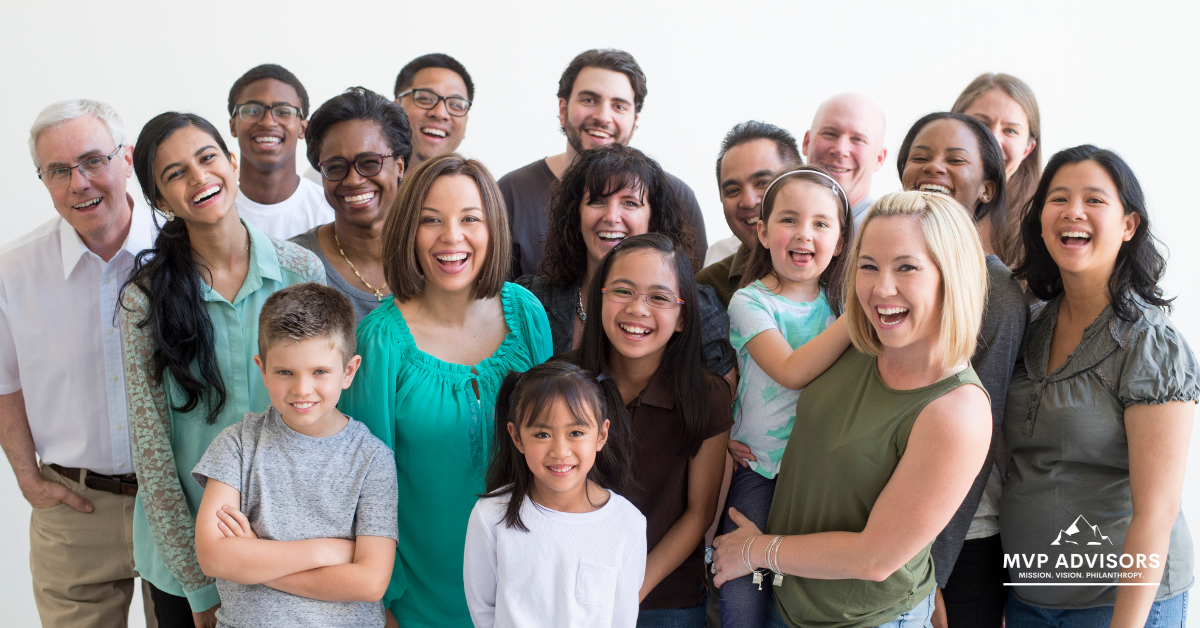
Having a well-defined nonprofit target audience isn’t a nice-to-have. It’s a must.
We’ve heard the questions before:
Does my nonprofit really need a target audience?
Can’t I just target everyone in my area and hope something sticks?
Why don’t we just save time by sending out the same thing to everyone in our network?
To be candid, when you try to reach everyone in the same way with the same message, you aren’t going to resonate with many (if any) people.
Putting in the time and effort to thoroughly understand the people who are most likely to engage with your organization will make your outreach more effective in the long run.
Here, we’ve broken down the process into three easy-to-follow steps that will help you define, segment, and reach your ideal nonprofit target audiences.
What is a Target Audience?

First, let’s back up and talk about what a target audience actually is.
We already covered what a target audience isn’t. It’s not everyone who has ever engaged with your nonprofit. It’s not everyone in your nonprofit’s service area. And it’s certainly not everyone in your country, state, or even city.
A target audience is defined as a group of people most likely to be interested in using, purchasing, or supporting a product, service, or messaging. They are often grouped due to one or more common characteristics.
Most companies have more than one target audience – in fact, many have a different target for every product, service, program, or event.
A nonprofit target audience is no different. And understanding your organization’s audience(s) makes your campaigns and communications more focused, efficient, and effective, from your brand voice to your content.
Let’s dive into how you can make that happen!
3 Steps to Defining a Nonprofit Target Audience

While there are several different approaches to defining a nonprofit target audience, we recommend starting with a simple, three-step process:
- Selecting your primary audience(s)
- Segmenting your primary audience(s)
- Developing target audience personas
These steps not only help you determine who your nonprofit’s ideal audience is, but they also ensure you really get to know them.
MVP Playbook Resource: Use our free Target Personas Worksheet to guide you through developing your own target audience personas.
Step 1: Select Your Primary Target Audience(s)
First up is selecting the primary target audience – or audiences – for your nonprofit.
Remember that these are groups of people who share similar characteristics. They are those who are most likely to be interested in your nonprofit and what it has to offer.
What to Consider with a Primary Target
There are three things to look at when developing your primary target audiences.
- Consider your offerings, such as your services and/or programs. Ask yourself what problems they solve and who will benefit from them or be interested in supporting them.
- Review internal and external data. Look at your website, social media, and email analytics – as well as things like volunteer and donor data – to see who is already engaging with you and how. Externally, do the same for similar organizations.
- Create groups based on similar characteristics, such as demographics, interests, and behaviors.
Many nonprofit organizations group their primary target audiences by behavior. This behavior may be based on previous interactions with the nonprofit or on actions the organization hopes these people will take (such as current and potential donors).
How Many Primary Target Audiences for Nonprofits?
The number of primary target audiences your nonprofit has is completely up to you, your offerings, and your goals. This number may also shift depending on the intended use.
If you are developing targets for an overarching strategic or communications plan, you’ll likely have more primary audiences than you would for a specific program, event, or fundraising campaign. Campaigns with specific goals, like planned giving, may only have one primary target, and that’s ok!
Let’s take a look at three ways a nonprofit may create a set of primary target audiences based on behavior and goals:
Example 1: A local children’s nonprofit that offers direct services and requires a lot of volunteer hours is developing an overarching strategic plan. They have decided on three primary target audiences: donors, volunteers, and caregivers of the children served (aka beneficiaries).
Example 2: A large university is working on a communications plan for the year. The team has realized a need to reach six primary target audiences: potential students, current students, alumni, parents/family of students, volunteers, and donors.
Example 3: A foundation that provides grants to other nonprofits is promoting recurring giving to existing one-time donors, so that is their sole primary audience for this specific campaign.
It’s also important to note that some of your audience members may fall into more than one primary target. For example, several of your volunteers or even former beneficiaries may also be donors.
You also want to take care not to get too nitty-gritty with your primary target audiences. You’ll get into more detail in the next step: segmentation.
Step 2: Create Nonprofit Target Audience Segments
You’ve already decided on your nonprofit target audience, so why do you need to segment them further?
Further segmenting your primary target audiences into subgroups (aka segments) helps you select appropriate marketing channels and hone your messaging.
You wouldn’t want to reach out to a current major donor with information about making a first-time gift. Or tell all of your beneficiaries about a program that is only available to a certain age group or region.
To create nonprofit audience segments, there are four types of segmentation to consider: demographic, geographic, psychographic, and behavioral.
You may use each of these types of segmentation to create your target audience subgroups. Do take care, however, not to create segments that are too specific! Attempting to reach several hyper-segments (especially if there are only a handful of people in each) will take too much of your precious time and effort.
Here’s a bit more about each of the four factors to consider with segmentation.
Demographic Segmentation
Demographics are quantitative or statistical characteristics of a population. These include data like age, gender, marital status, household income and size, education, and occupation.
Geographic Segmentation
This is simply the geographic location of your audience, such as city, state, region, or country.
Psychographic Segmentation
Psychographics go beyond statistical data and often give a better picture of the psychological traits that influence actual behavior. In short, they show the “why”. These traits may include a person’s values, beliefs, opinions, lifestyle, hobbies, interests, and media consumption.
Behavioral Segmentation
Behavioral factors indicate how consumers have interacted with a product or company, such as usage, purchase behavior, customer journey, and loyalty. For a nonprofit target audience, look at behavior such as history and engagement with the organization (giving behavior, volunteer hours, etc.), stage in their journey, or level of satisfaction.
Advice from the Playbook: Don’t work alone! Collaborate with other departments or teams in your organization to uncover the data you need.
Step 3: Develop Target Personas
Once you’ve determined your nonprofit target audience segments, we suggest going one step further: developing target personas.
Target personas are profiles of fictional people that represent your primary target audiences and segments. These personas have the same characteristics as your ideal donors, volunteers, or beneficiaries.
To develop your own, consider each persona’s:
- Background (demographic and geographic)
- Hobbies and interests (psychographic)
- Values (psychographic)
- Motivations (psychographic)
- Pain points and challenges (psychographic)
- Media consumption (psychographic)
- History with your organization (behavior)
- Stage in donor/client/volunteer journey (behavior)
Creating target audience personas help you better visualize, understand, and engage with your intended audience. Whenever you’re developing strategy, writing content, or designing outreach, picture your selected persona. Is this something they’ll connect with and respond to? If not, you may need to switch up your plan or messaging!
Nonprofit Target Audience Persona Examples

Not sure what a persona looks like? Use these target persona examples to help you define and reach your own nonprofit target audience!
Can you spot the demographic, geographic, psychological, and behavioral characteristics?
Example 1: New Volunteer for an Environmental Organization
Background: Henry is a male in his early 20s. He is not married nor does he have children and he recently graduated from a state university. He currently rents an apartment in the same city as this organization and is working in an entry-level position at a local accounting firm, making around $50K per year.
Psychographics: In his free time, Henry enjoys hiking and fishing. He listens to music on Spotify, watches YouTube videos, occasionally checks Instagram, and streams his favorite shows and movies. Henry values preserving natural resources and habitats. He is motivated to support organizations that are on a mission to do the same, but his challenge is that he does not have a lot of money to donate at this time.
Behavior: Henry has previously volunteered once for the organization by joining a beach clean-up effort. At the time, he expressed interest in joining more volunteer efforts, so he is considered to be in the “Engagement” stage – the nonprofit needs to continue reaching out to him with relevant opportunities.
Example 2: Potential Major Donor for a University
Background: Veronica is a female in her 50s. She is currently married, is working as an architect, and graduated from the university. Her household income is approximately $300-$500K. She and her partner have three children, one who is attending the university and two others who are still living at home.
Psychographics: In her free time, Veronica loves to read fiction books, work in her garden, and travel with her family. She watches cable TV, streams some movies, and reads Better Homes & Gardens magazine. On social media, Veronica is fairly active on Facebook, which she mostly uses to keep up with her children. Veronica values higher education for many academic and social reasons and was a part of a sorority while attending the university. She is motivated to support her university to provide her children (and others) with the same experiences and opportunities she had, but her challenge is that she does not have a lot of time to volunteer.
Behavior: Veronica and her partner have become regular donors, routinely giving at least once each year. Each gift amounts to approximately $2,500-$5,000. She is in the donor retention stage, and the nonprofit is actively in contact with her to ensure ongoing support.
MVP Playbook Resource: Discover another example in our Target Personas Worksheet!
Start Connecting with the Right Audience
Whether planning for year-end fundraising or developing a multi-year strategic plan, defining and understanding your nonprofit target audiences will make your outreach more efficient and effective.
Remember to follow these three steps:
- Select your primary target audience(s).
- Segment those primary target(s).
- Create target personas to represent those segments.
Looking for help developing and reaching your nonprofit target audience? MVP Advisors is here for you! We’re an experienced group of nonprofit consultants ready to offer a hand in campaign planning, content development, donor prospect research, and more.
Book a call or email us today to see how we can work together.
